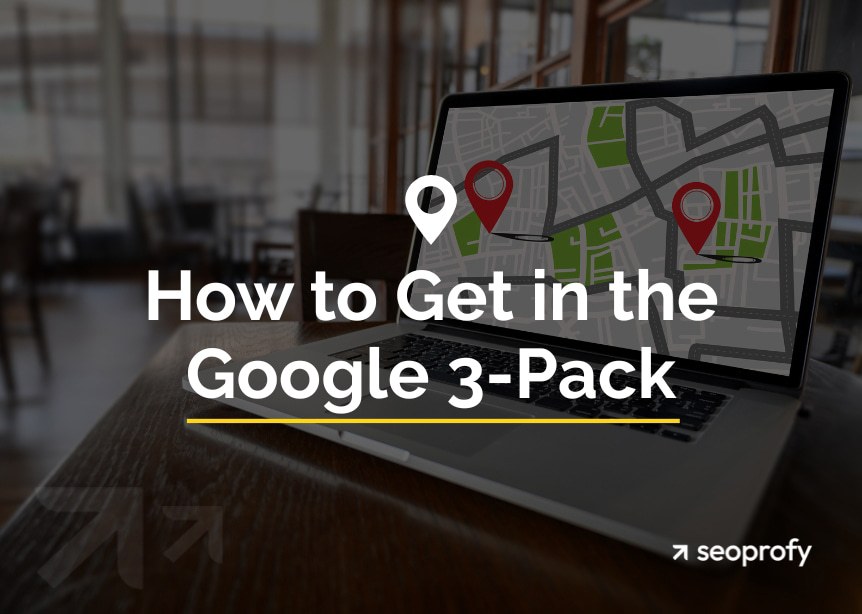When most people hear “keyword strategy,” they picture a list of words in a spreadsheet. Although that’s a part of it, there’s a research-intensive process behind it that connects what your audience is searching for with what your business offers. In other words, it’s the bridge between user intent and your goals that directly impacts your visibility in search.
In this guide, we’ll share with you nine actionable steps on how to choose the right keywords for your strategy. You’ll learn about both paid and free tools you can use in this process and get advanced tips on how to turn your target terms into content ideas that attract and convert your audience in the long run.
- A keyword strategy helps you map the content to the search behavior of your target audience and ties it back to your business goals.
- Search intent, audience pain points, and the sales funnel are the main factors that should guide your keyword selection.
- To find keyword ideas that already perform well in your niche, you can use competitor analysis features in tools like Ahrefs and Semrush.
- Organizing keywords into clusters around central topics helps you strengthen your topical authority and improve rankings.
- Long-term growth in SEO comes from ongoing tracking of keyword performance and adjusting the strategy based on the data at hand.
What Is Keyword Strategy?
An SEO keyword strategy is the plan for choosing which search terms your website will target and how those terms align with your business priorities. It sets the direction for what you publish and how your pages show up in search. Overall, every choice you make around keywords can influence your performance and the results you get from your site.
Why Do You Need a Keyword Strategy?
A successful keyword strategy puts your content and campaigns on the same track as your customers’ searches. This means you don’t waste time on topics that bring the wrong visitors, or none at all. Here are some other reasons why it matters:
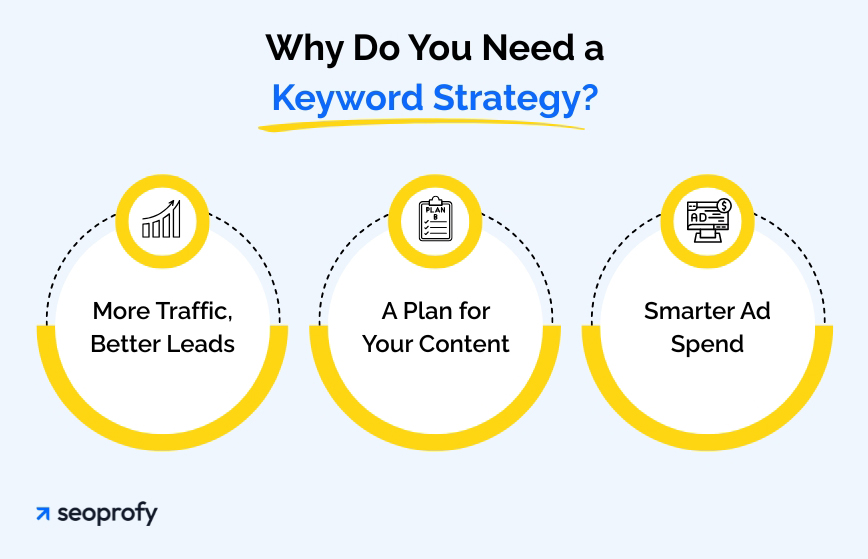
More Traffic, Better Leads
When you choose queries that line up with what your target audience already types into Google, your pages land in front of the right people and bring in leads that fit your business.
A Plan for Your Content
A keyword strategy in SEO helps you decide what to write and why. It gives structure to your content plan, so each page on your site targets a specific query, supports your business goals, and fits somewhere in the buyer’s journey.
Smarter Ad Spend
Paid search works best with tight keyword targeting. When you know which phrases convert, you can lower your costs and get your ads in front of more buyers.
What Keyword Strategy Should Be Based On?
In contrast to conducting keyword research, where you usually just gather a long list of potential terms with metrics, strategy is more comprehensive and takes into account several factors:
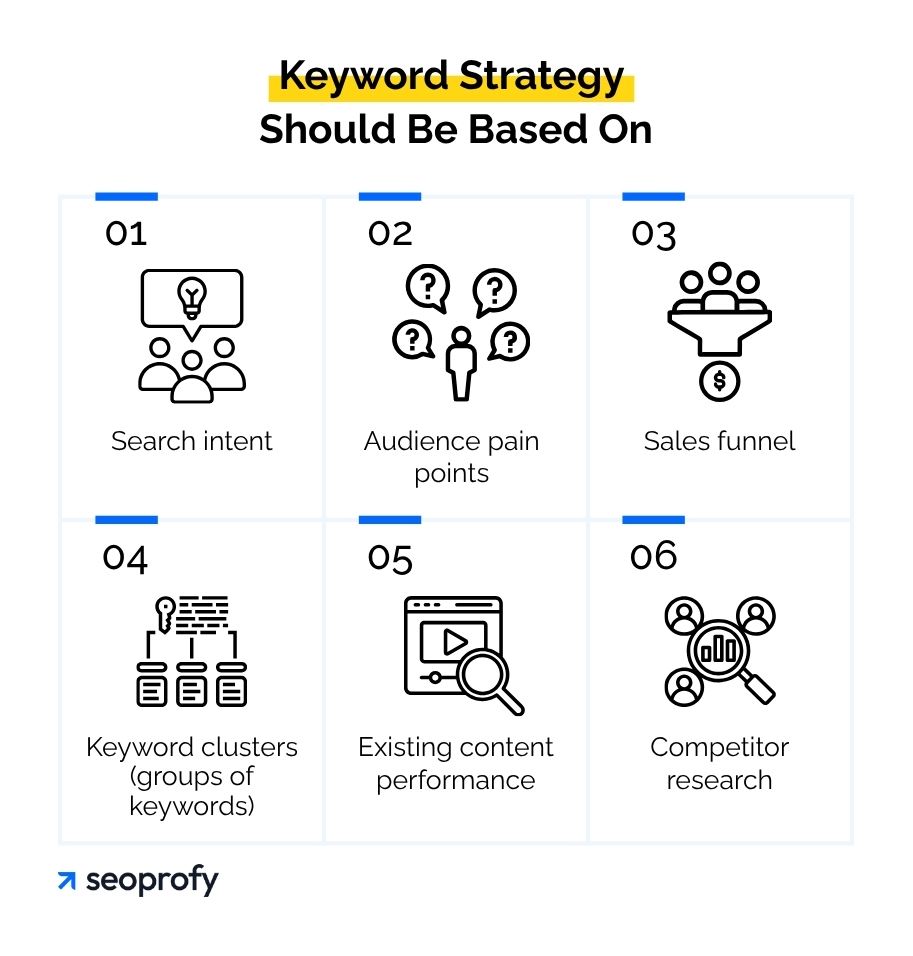
- Search intent: Choose keywords that match what people type into search engines.
- Audience pain points: Address the specific problems and questions your target customers have.
- Sales funnel: Use keywords that fit each step of the buying process.
- Keyword clusters: Group related keywords to cover topics more thoroughly.
- Existing content performance: Use data from your current pages to guide new topics.
- Competitor research: Check which keywords competitors rank for and find gaps in your own strategy.
We’ll go more into detail on each of these factors in the following sections.
Want your site to show up for the right searches? We design personalized keyword strategies using industry and custom-built tools, so you can see more traffic and sales from your site. We’ll help you:
- Identify valuable keywords for your business
- Find low-hanging fruit opportunities
- Optimize your existing pages

How to Create a Keyword Strategy: Steps and Tips
Let’s now go through nine steps to help you build a strategy.
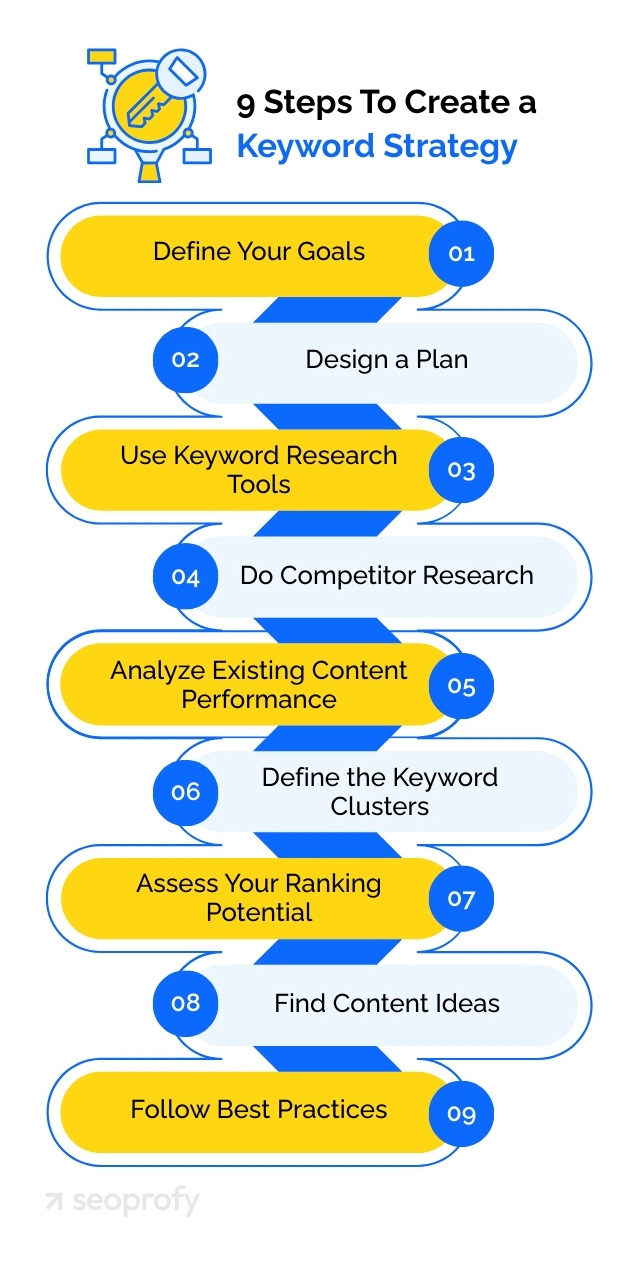
1. Define Your Goals
The best keyword strategy always starts with your business and SEO objectives. What are the outcomes you’re hoping to achieve? Brand awareness, leads, conversions? And just as important, who do you want to reach?
Answers to these questions will inform the keywords you choose, the type of content you create, and the metrics you track. To put it into perspective, if your main goal is lead generation for a B2B SaaS product, you’ll likely focus on bottom-of-funnel keywords, product-focused content, and conversion paths.
But if you’re in an early-stage brand-awareness phase, your strategy will lean more toward top-of-funnel terms and educational resources. Without these decisions upfront, it’s easy to chase keywords that look promising but have no real value to your business.
2. Design a Plan
This is the step where you create an action plan that lays out all the tasks you need to complete. Think about who’ll work on these tasks in your team, decide on the tools you’ll need, and set deadlines.
If you don’t have experts in-house to assign it to, you could outsource this part of SEO to a freelancer or an SEO agency. It will give you access to specialized skills, and you won’t need to hire someone full-time.
3. Use Keyword Research Tools
Now that you have your plan, it’s time to gather some data. For this, you’ll need keyword research tools. The good news is that you don’t need to buy them all. You could start with the basics, such as Google Keyword Planner.
Although this tool is primarily used for Google Ads, it gives you some keyword metrics to work with if you’re on a tight budget. It shows how often a keyword gets searched per month and how competitive it is, which is helpful in determining what terms are easier to rank for.
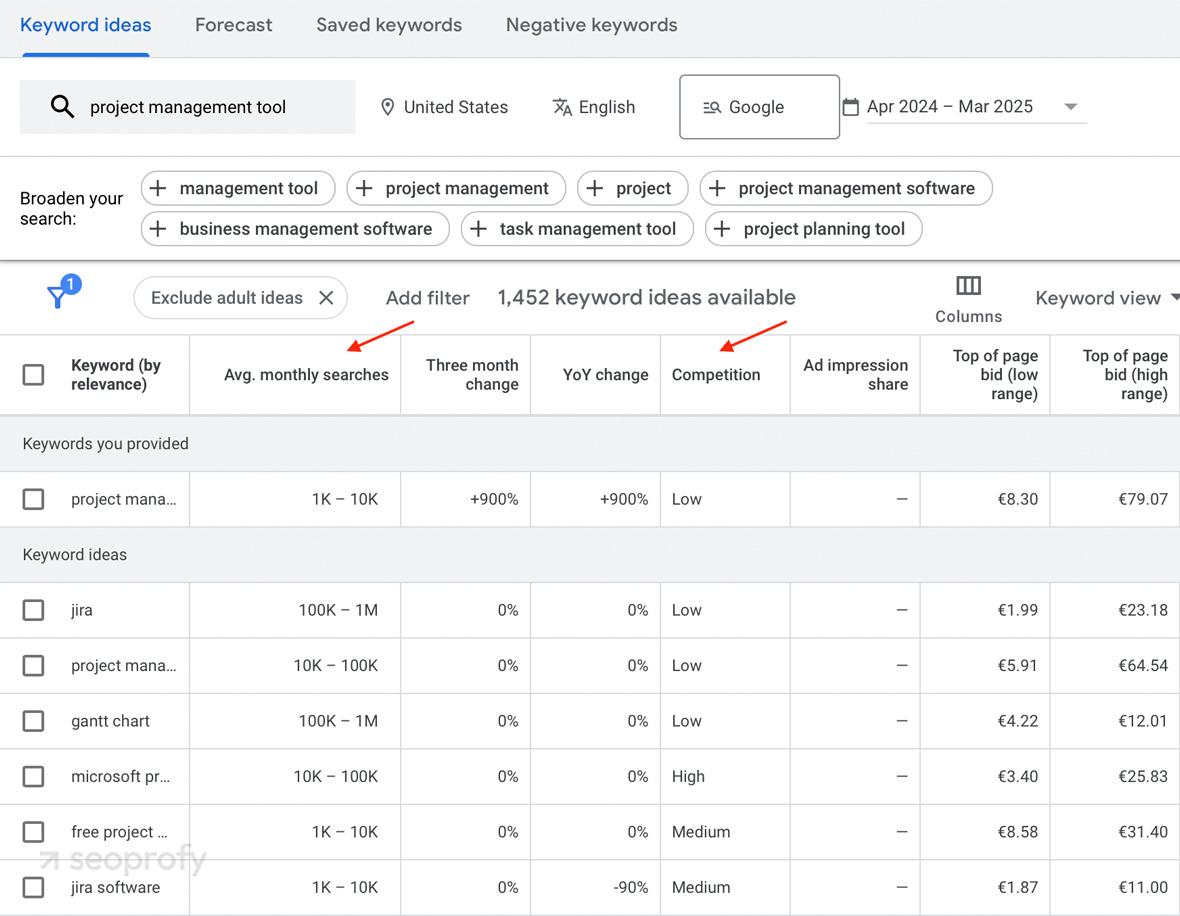
If you prefer more advanced options, Ahrefs and Semrush are some of the best SEO tools out there. They provide a broader analysis of your target keywords and overall site performance. Here’s what you’ll see in Ahrefs once you type in your seed term into the tool:
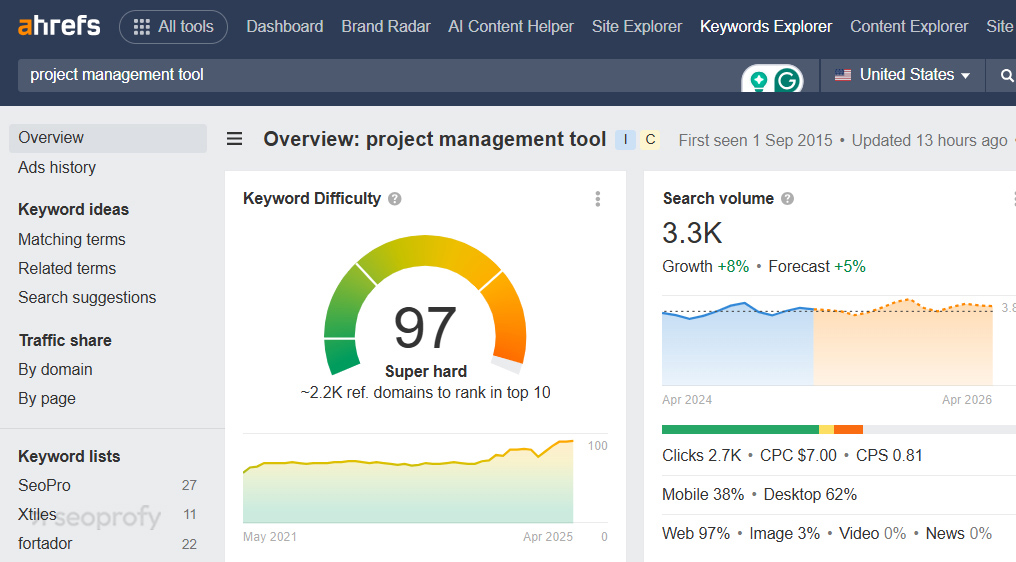
You can then navigate to the matching terms report to find similar keywords. There’s also an option to filter the terms by keyword difficulty (KD), volume, domain rating (DR), search intent, and even questions people are asking (helpful if you’re planning blog topics or FAQs).
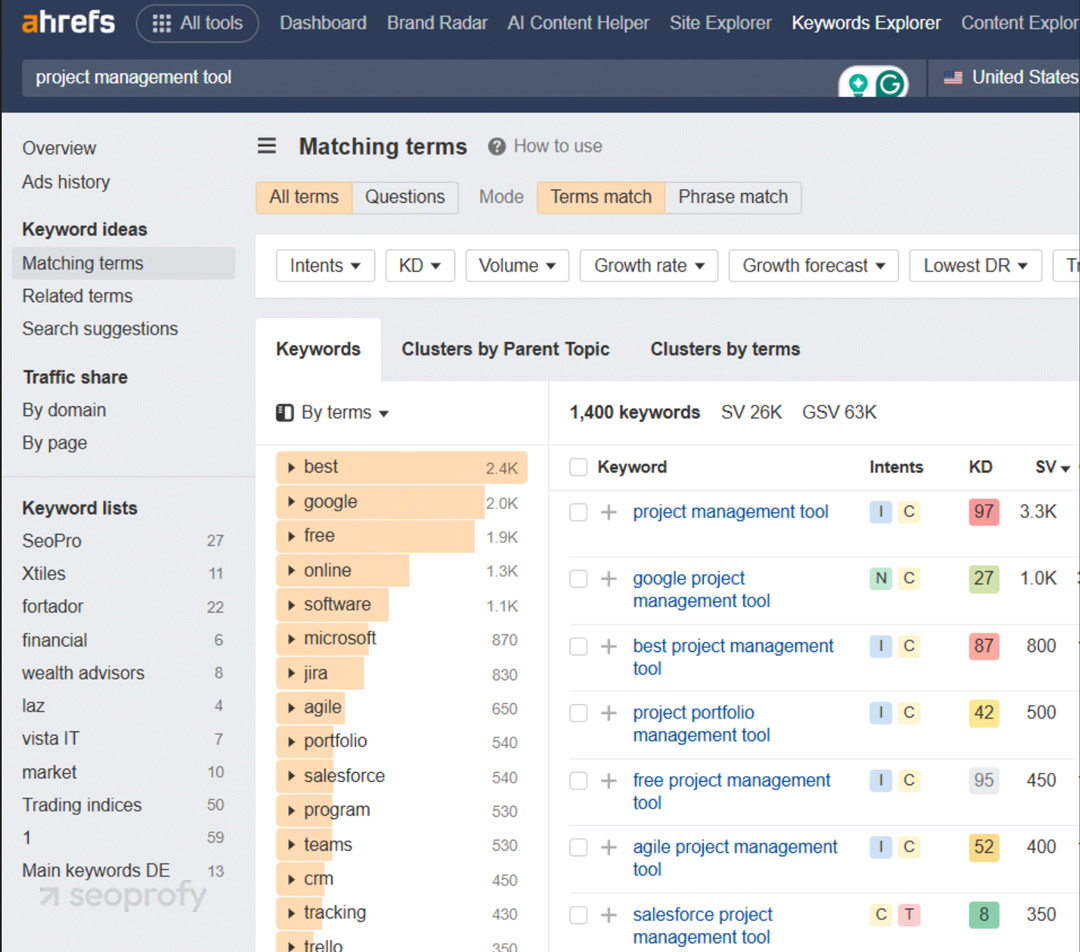
As for Semrush, you can find similar metrics on its dashboard. Notice that there’s also CPC data, which can be useful to understand if keywords have commercial intent.
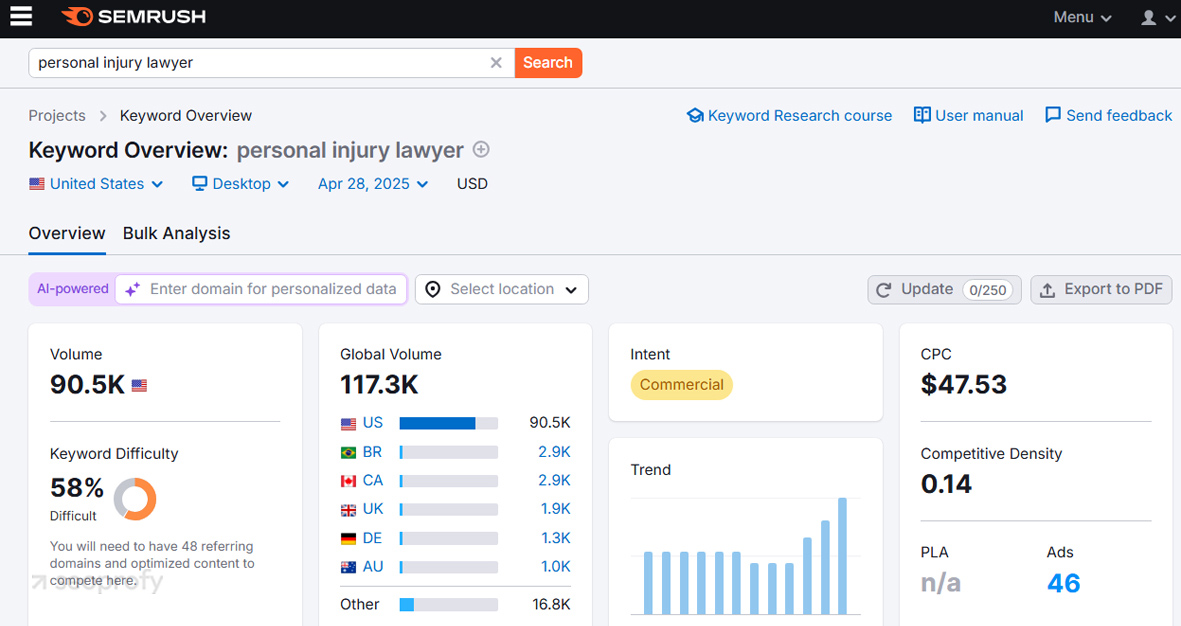
If you scroll below, you can also see questions and pillar ideas you can use when building a keyword strategy.
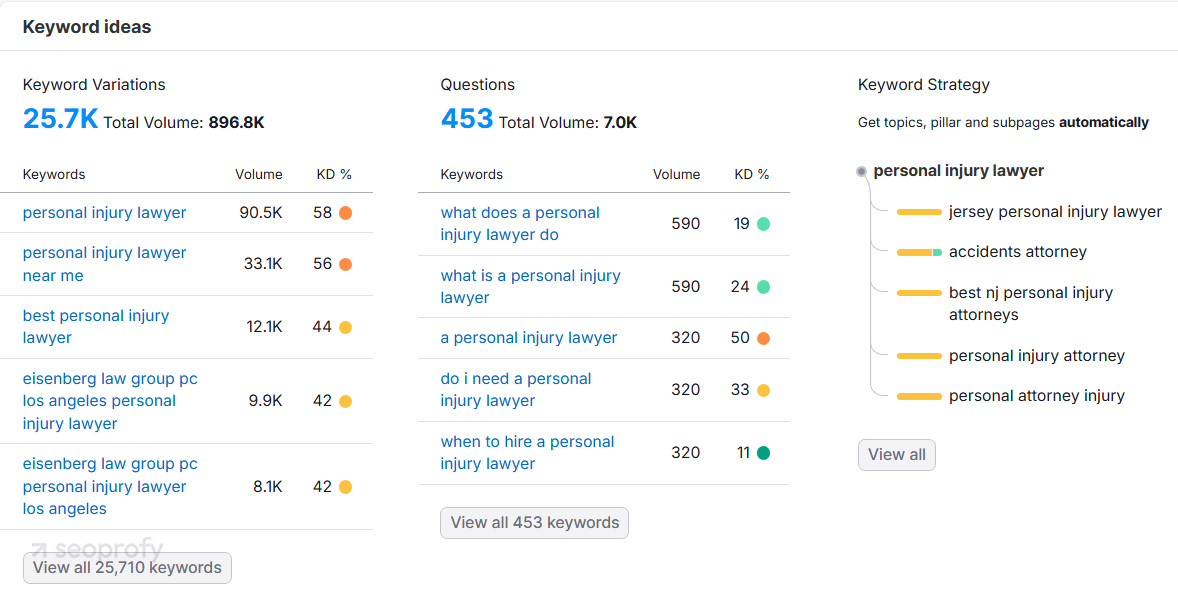
Another useful feature you can use in Semrush is the Keyword Magic Tool. It’s the place where you can find a big list of keyword opportunities around your main topic. There’s also a Low-Hanging Fruit tab. This section points out terms with less competition so you can find good targets for your campaigns.
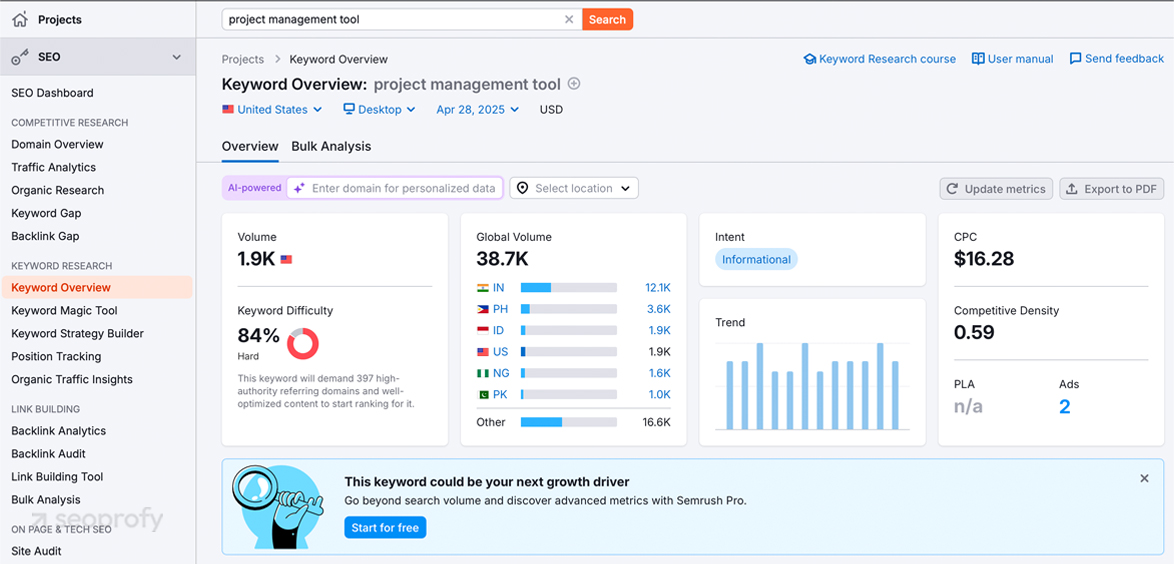
Of course, let’s not forget about AI tools. ChatGPT has become an assistant to many SEO specialists in recent years and can be used in multiple ways. It can help you brainstorm keyword lists or even analyze your competitors in seconds. We’ve shared more use cases in our article on AI SEO tools, so if you’d like to learn more, make sure to check it out.
Bottom line: Pick the tools for your SEO keyword strategy that fit your needs and your budget. Use them to collect ideas and get a feel for where you can compete.
4. Do Competitor Research
A shortcut for pulling a list of keywords is to turn your attention to the other sites that show up for the searches you want. Most paid keyword research tools, like Ahrefs or Semrush, have competitive analysis features and let you enter your domain and see which sites compete with you for the same keywords.
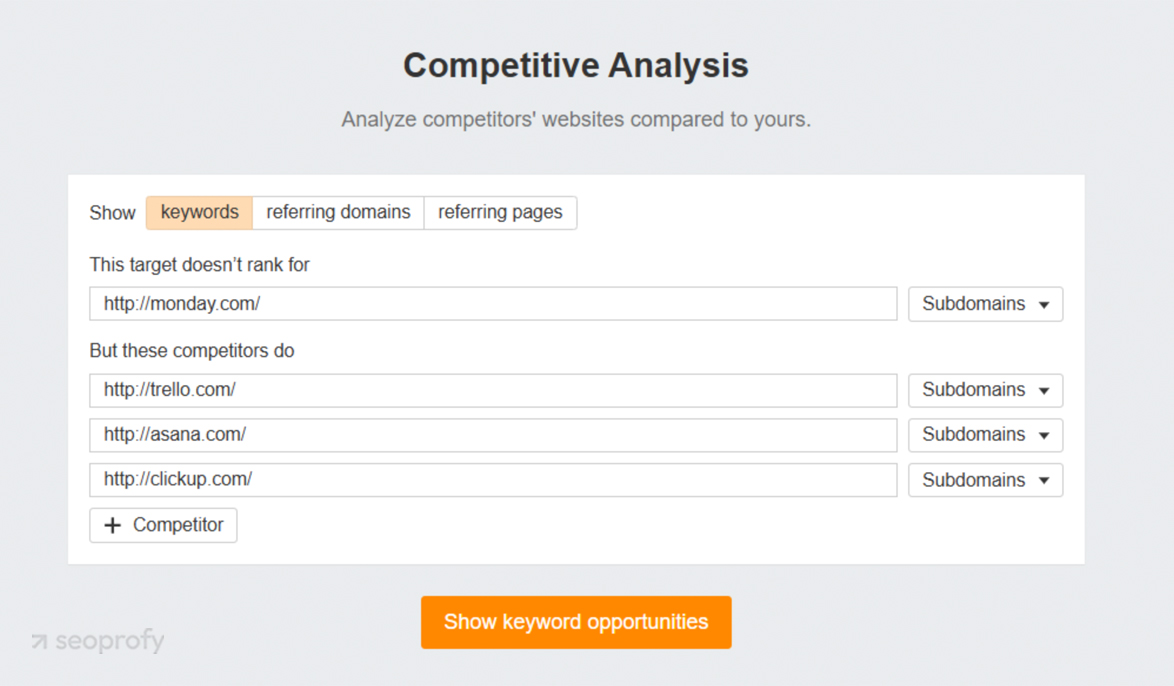
You can check which pages bring those sites the most traffic and where the gaps are. Here’s how you can do it in Ahrefs’ Site Explorer:
- Enter your competitors’ domains.
- Look at their top pages and sort by estimated traffic.
- Make a note of the specific keywords tied to those pages.
- Pay attention to terms you haven’t targeted yet.
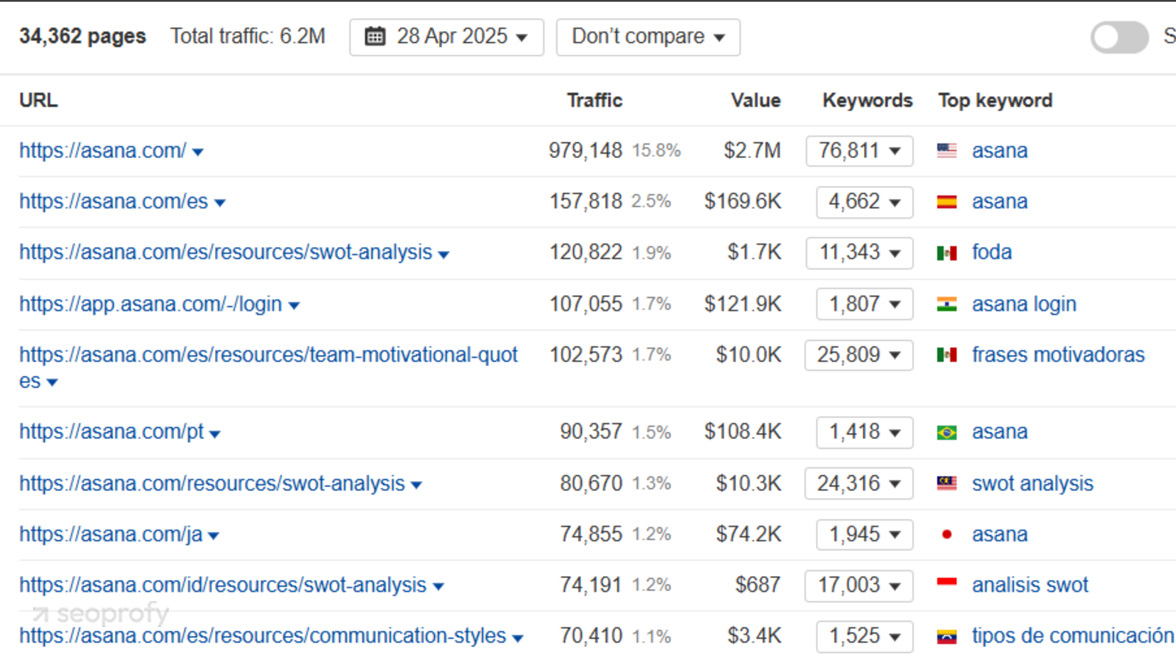
Next, use the “Content Gap” feature in Ahrefs or the “Keyword Gap” tool in Semrush to compare your site directly with a few of these competitors. You’ll get a list of keywords they rank for that you don’t.
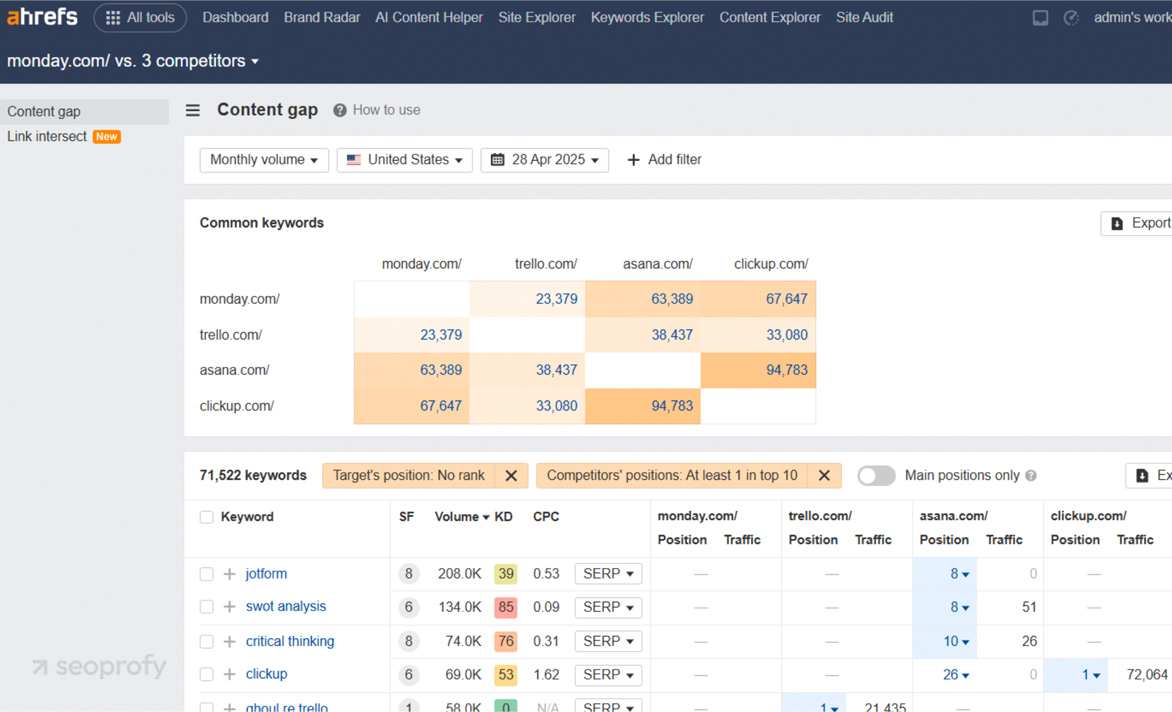
If a competitor is ranking for relevant keywords that match your goals and audience, save it to your list. At the same time, check how they approach the topic — their page structure, headings, and what questions they answer. This will give you an idea of how to write content when you start building or updating your own pages.
5. Analyze Existing Content Performance
Before you develop a keyword strategy, take a hard look at what you already have. For this step, two tools can be helpful: Google Search Console (GSC) and SE Ranking.
In Google Search Console, head to the Performance report. Here, you’ll see key metrics like:
- Impressions (how often your pages appear in search)
- Clicks (how many people visit from search)
- Average positions for each keyword
To get even more data on your current keyword performance, you can use SE Ranking. This tool pulls together all the keywords your site ranks for and shows you how your positions change over time.
You can see which pages rank for the most keywords and filter by average position. Look for URLs that show up a lot but never break into the top 5 — those are the low-hanging fruit you can work on to move up with small updates.
Both GSC and SE Ranking let you export the data, so you can filter and flag the URLs with the best opportunity. The goal here is to find pages that could be better optimized or expanded to push them to the top of the search engine results pages.
6. Define the Keyword Clusters
You’ll also need to organize your keywords into topics and connect them to a broader theme, often called a content pillar or cluster. A content pillar is your main topic (like “project management software”), and each cluster builds around it with related terms and variations.
To build clusters for your keyword strategy, you can use tools like Ahrefs, Semrush, or SE Ranking. In Ahrefs, for example, terms are automatically grouped under a parent topic based on how Google interprets the query. This helps you see which keywords can realistically be targeted together on one page and which ones need separate content.
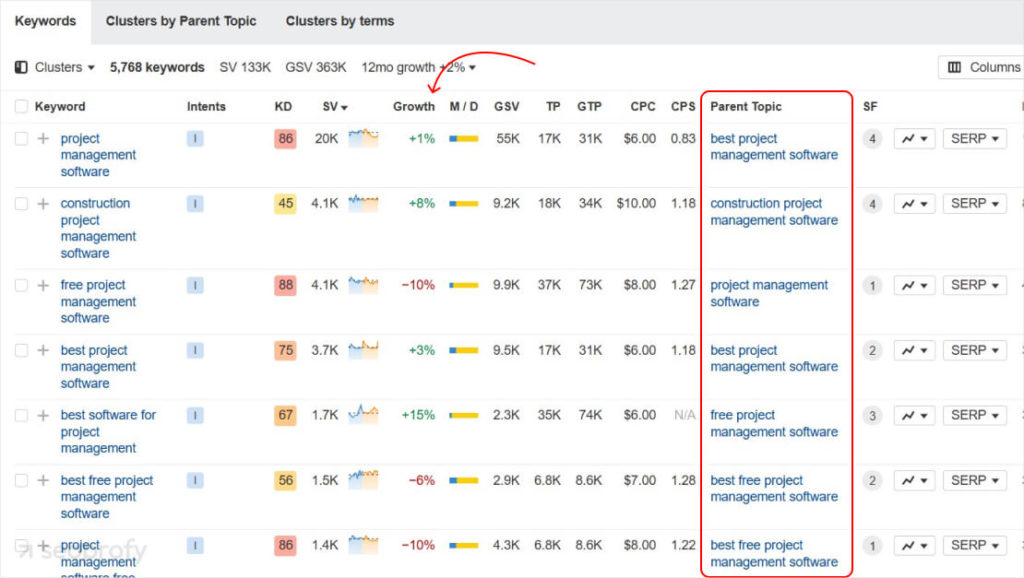
You’ll also notice the Growth column. That shows how interest in a keyword has changed over the last 12 months. A term with rising search volume could mean there’s a good opportunity to publish sooner.
When you organize your keywords this way, your site feels more complete to your readers. It also signals your topical authority, which can lead to better rankings in Google search results.
7. Assess Your Ranking Potential
A good keyword strategy also means knowing which terms are worth targeting. So, before adding any terms to your campaigns, take a minute to see if your site can rank for them. Two metrics you should pay attention to are keyword difficulty and monthly search volume. Let’s look at both in more detail below.
Keyword Difficulty
KD is a score from 0 to 100 that tells you how many other websites are already targeting a keyword. A higher number generally means more competition. For example, the word “project management tool” has a difficulty score of 84 in Semrush’s keyword overview tool.
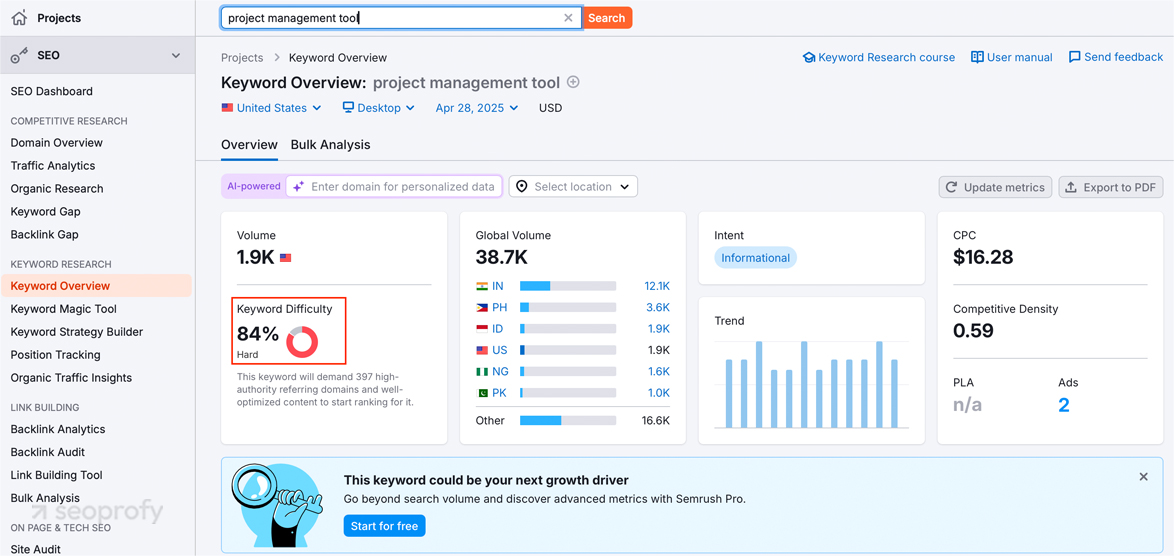
If your website is still growing, you’ll have a better chance if you pick something less competitive. To find better opportunities, you can go to the Keyword Magic Tool and filter words by KD or click on the Low-Hanging Fruit Tab. You’ll get query ideas with lower scores, which are easier to rank for.
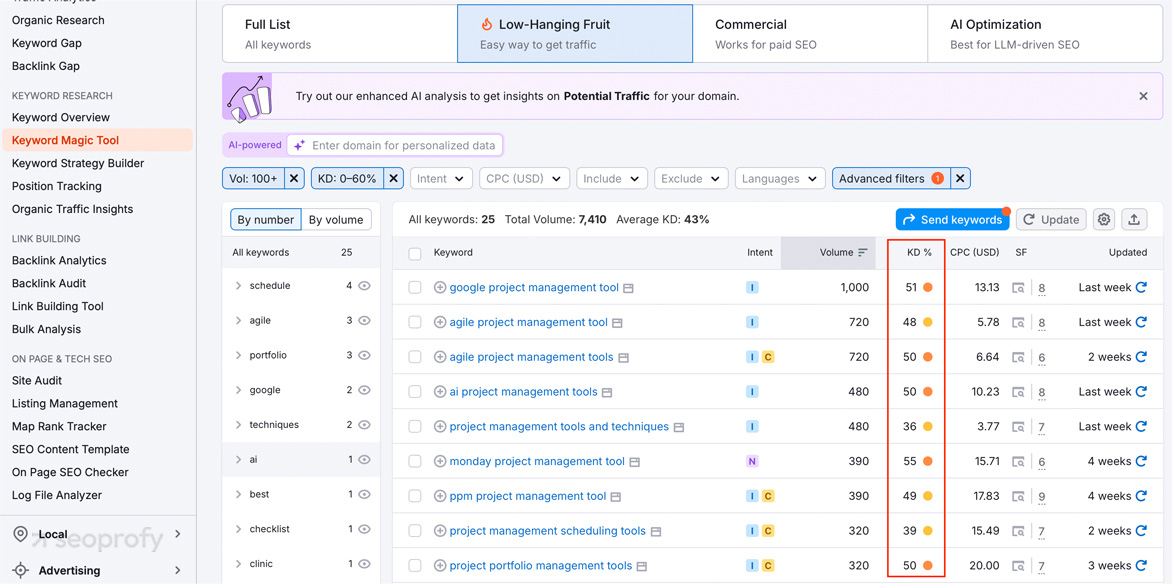
Monthly Search Volume
This metric shows how many people are searching for a certain keyword each month. Although you should aim for terms with decent search volume, a lower number isn’t always a bad thing. It can mean you’re reaching a more niche group of readers who are closer to making a decision.
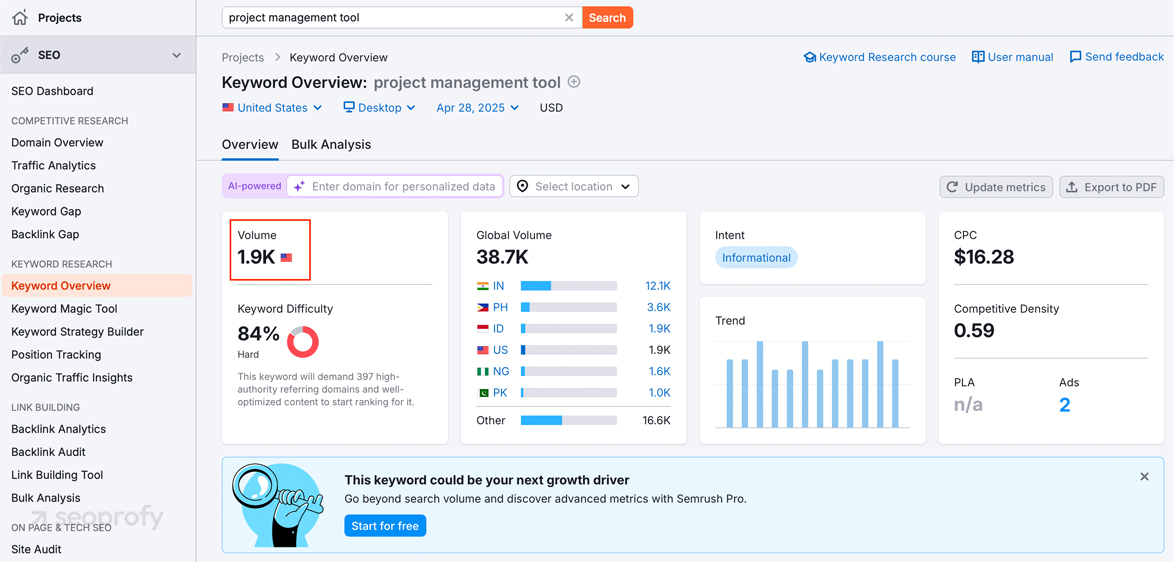
When choosing keywords, pick the ones that match your website’s current strength. High search traffic may sound enticing, but if the term is hard to rank for, you’ll likely end up buried by larger sites. Meanwhile, a series of queries with lower competition can steadily bring visitors to your site and help you grow over time.
8. Find Content Ideas
After you’ve narrowed down which terms are realistic to go after in your keyword strategy, the next step is to figure out how to turn them into content. This is where it helps to work with other teams — the ones who hear your customers’ questions and pain points directly. Here’s how to do it:
- Ask your customer support team to export a list of the most common customer questions from the past month. If customers repeatedly ask the same things, these topics are worth turning into step-by-step guides or FAQs.
- Review internal site search and check what people type into your website’s search bar. If you run an online store and “return policy” shows up often, write a page or add a helpful article about it.
- Use Ahrefs or Semrush to find your competitors’ top-performing articles. Look through them and check if any topics are relevant to your business.
- Type your main keyword into Google and jot down the auto-suggestions. Also, click through the PAA questions for any questions or ideas you can target.
Want even more advanced sources?
- Set up Google Alerts for your main topics to pick up trends or news as they happen.
- Use AnswerThePublic to visualize the questions people type into Google.
- If your sales team logs calls, ask for access to call transcripts and search for repeated words or phrases.
Then, assess both the search and business potential of these content ideas and put them into a shared spreadsheet. Add columns for Source (support ticket, sales call), Potential Traffic (based on keyword research), and Business Priority.
This way, you can keep your SEO content strategy full of topics that are tied to the concrete needs of your target audience. And, of course, remember to map each idea to the appropriate stage of the buyer’s journey (more on that in the next section).
9. Follow Best Practices
As with anything in SEO, there are certain best practices you can follow to build a keyword strategy that moves the needle for your business. Let’s go through them.
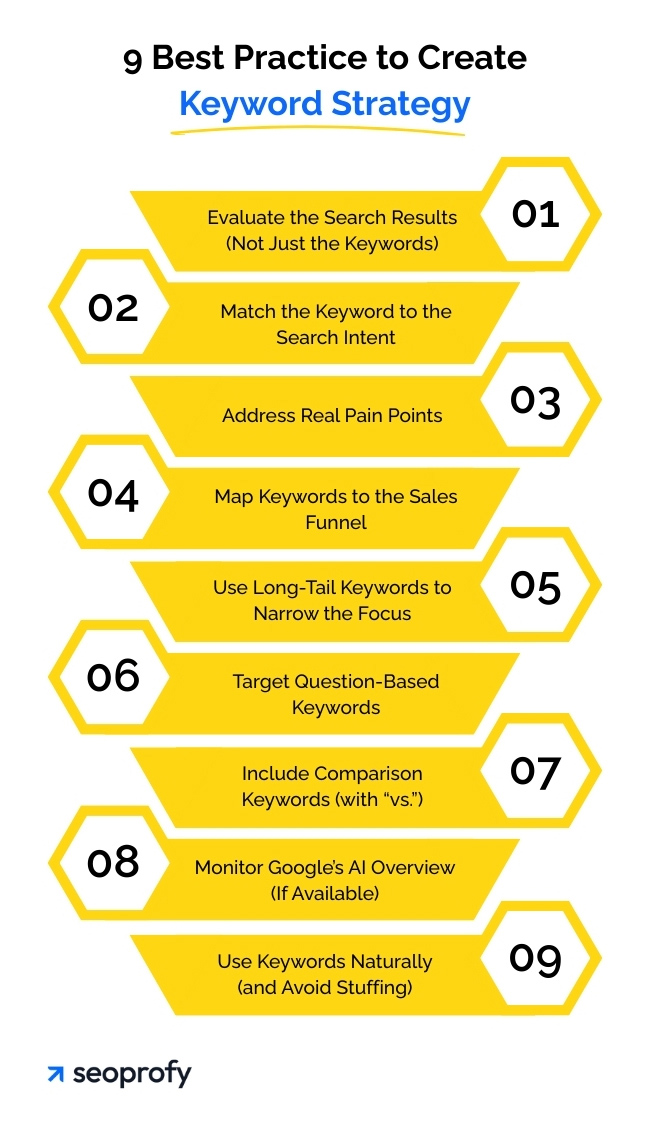
Evaluate the Search Results (Not Just the Keywords)
The volume and difficulty scores we reviewed earlier are important, but you’ll also need to search the keyword on Google to study the sites and types of content that are already ranking. This shows what format Google prefers and also who you’re going to be competing against.
Match the Keyword to the Search Intent
Search intent tells you the reason behind someone’s search. There are four main types:
- Informational: “How to manage remote teams”
- Navigational: “Notion login”
- Transactional: “Buy CRM software”
- Comparative: “Trello vs Asana”
Make sure your content answers that intent. Otherwise, it won’t be able to rank well in search results, no matter how well it’s written.
Address Real Pain Points
Keywords should always connect to problems your target audience wants to solve. We already walked through how to find those in the content ideas section earlier, so if you need a reminder, go back and check it. It’ll help you create pages that answer what your potential customers are looking for.
Map Keywords to the Sales Funnel
People visit your site at different points in their buyer’s journey. Some are just starting to learn about the problem they have, whereas others are ready to make a purchase.
To match your pages to each stage, you can use a keyword mapping strategy. It helps you assign each term to the most relevant page type: blog posts for top-of-funnel searches, product pages for bottom-of-funnel queries, and so on. Let’s now look at the stages in more detail.
- Top of Funnel (Awareness): People mostly use informational searches like “how to” or “what is” and want to learn more about the topic.
- Middle of Funnel (Consideration): Users are in their research phase. They look for content types, such as listicles, comparison posts, and case studies.
- Bottom of Funnel (Decision): Prospects are typing in conversion-focused keywords. These are terms related to pricing, free trial, or demo requests.
Use Long-Tail Keywords to Narrow the Focus
Longer phrases have lower search volume, attract 1,76% more clicks, and bring in visitors with stronger intent. Since these terms are less competitive and more specific, it’s worth having a long-tail keyword strategy in your SEO campaigns.
Target Question-Based Keywords
Targeting question-based queries is a solid keyword strategy move that helps you match early-stage search intent — the users who are still researching and need information before they make a decision. It’s also a smart way to increase your chances of winning featured snippets or being shown in Google’s People Also Ask results.
Include Comparison Keywords (with “vs.”)
People love side-by-side comparisons, and when they’re searching for these, it means they’re further down the buyer’s journey. In your posts, use a simple table to compare pricing, features, and pros/cons. This format tends to perform well in search results and increase the time spent on the page.
Monitor Google’s AI Overview (If Available)
If your keyword triggers an AI-generated overview at the top of the search results, take note. What answers is it pulling? Which sites does it link to? Try to match the structure of those sources, and consider adding schema markup to make your content more visible to AI summaries.
Use Keywords Naturally (and Avoid Stuffing)
Keyword stuffing is against Google’s spam policies, so remember to use the target terms sparingly in your content (ideally below 3%) and always write for humans first. Use the keywords only where they fit naturally, and use semantic synonyms to add some variety.
9. Track and Measure Performance to Further Keyword Strategy Optimization
Everything you’ve done so far (research, planning, content creation) only makes sense if you keep an eye on your SEO performance. Without tracking, you’re guessing. And in SEO, guessing doesn’t get you far. Here are three tools worth checking regularly to adjust your strategy as you go:
- Google Search Console: Shows which keywords bring up your pages in search, how often your pages are seen, how many clicks you’re getting, and your average ranking. You can also check keyword performance by page and notice terms you didn’t plan for but are showing up for anyway.
- Ahrefs: Lets you track keyword rankings across your site or for specific URLs. You can see which pages bring in the most visitors and which keywords are driving it. The “Top Pages” and “Top Keywords” reports help you monitor traffic shifts and identify underperforming content.
- Semrush: Useful for tracking how your target keywords perform over time. The “Position Tracking” tool shows daily or weekly movements and lets you break things down by device, location, or keyword intent. You can also compare your visibility with competitors and flag terms that are moving up or down.
Overall, SEO is a long-term effort. You’ll need to revisit it often and iterate based on data. This is how you’ll be able to attract organic search traffic consistently to your site and get more customers for your business.
Start Building Your Keyword Strategy
The success of your SEO starts with the foundation — an effective keyword strategy. And now you know all the steps to find, assess, and choose the right terms for your campaigns.
That said, if you need a reliable partner with years of experience in SEO, reach out to us at SeoProfy. We have worked with clients in many niches and helped them see more organic traffic and better ROI with our keyword research services. Let’s work together on a personalized plan that helps you get similar results.








